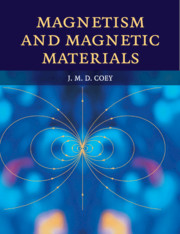Book contents
- Frontmatter
- Contents
- List of tables of numerical data
- Preface
- Acknowledgements
- 1 Introduction
- 2 Magnetostatics
- 3 Magnetism of electrons
- 4 Magnetism of localized electrons on the atom
- 5 Ferromagnetism and exchange
- 6 Antiferromagnetism and other magnetic order
- 7 Micromagnetism, domains and hysteresis
- 8 Nanoscale magnetism
- 9 Magnetic resonance
- 10 Experimental methods
- 11 Magnetic materials
- 12 Applications of soft magnets
- 13 Applications of hard magnets
- 14 Spin electronics and magnetic recording
- 15 Special topics
- Appendices
- Formula index
- Index
- Tables, conversions, constants and units
2 - Magnetostatics
Published online by Cambridge University Press: 05 June 2012
- Frontmatter
- Contents
- List of tables of numerical data
- Preface
- Acknowledgements
- 1 Introduction
- 2 Magnetostatics
- 3 Magnetism of electrons
- 4 Magnetism of localized electrons on the atom
- 5 Ferromagnetism and exchange
- 6 Antiferromagnetism and other magnetic order
- 7 Micromagnetism, domains and hysteresis
- 8 Nanoscale magnetism
- 9 Magnetic resonance
- 10 Experimental methods
- 11 Magnetic materials
- 12 Applications of soft magnets
- 13 Applications of hard magnets
- 14 Spin electronics and magnetic recording
- 15 Special topics
- Appendices
- Formula index
- Index
- Tables, conversions, constants and units
Summary
Back to basics
The dipole moment m is the elementary magnetic quantity, and magnetization M(r) is its mesoscopic volume average. The primary magnetic field B is related to the auxiliary magnetic field H and the magnetization by B = µ0(H + M). Sources of magnetic field are electric currents and magnetized material. The field produced by a given distribution of magnetization can be calculated by integrating the dipole field due to each volume element M(r)dV, or using the equivalent distributions of electric currents or magnetic charge. Magnetic scalar and vector potentials ϕm and A are defined for H and B, respectively. The internal, external and demagnetizing fields are distinguished. Internal field may be defined on a mesoscopic or a macroscopic scale, the latter in terms of the demagnetizing factor N. Magnetic forces and energies are related to magnetization and external field.
We begin with magnetostatics, the classical physics of the magnetic fields, forces and energies associated with distributions of magnetic material and steady electric currents. The concepts presented here underpin the magnetism of solids. Magnetostatics refers to situations where there is no time dependence.
The magnetic dipole moment
The elementary quantity in solid-state magnetism is the magnetic moment m. On an atomic scale, intrinsic magnetic moments are associated with the spin of each electron and a further contribution is associated with its orbital motion around the nucleus.
- Type
- Chapter
- Information
- Magnetism and Magnetic Materials , pp. 24 - 61Publisher: Cambridge University PressPrint publication year: 2010

